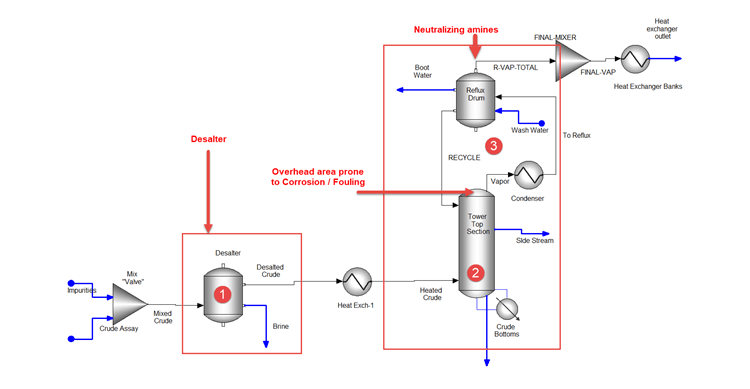
Crude Distillation Unit – Overhead Corrosion Prediction
In the Downstream Oil and Gas (O&G) sector, productivity and reliability are foundational to success. More than ever, companies are striving to adopt the latest operating methods and technologies in order to enhance downstream processes, enabling them to sustain production, boost yield, and increase profits while driving down operational expenses. However, companies’ industry-wide are facing a significant threat to production—corrosion.
Corrosion is a major issue for today’s downstream companies. Over time, these chemical reactions can lead to losses in productivity, increased maintenance fees, unplanned shutdowns, and even catastrophic failure. Corrosion is especially rampant in crude tower overheads due to hydrochloric acid. Once crude oil is transported downstream, it is run through a desalter to remove salts, solids, and other impurities; however, it is difficult to remove all contaminants, which then flow into the tower. Although hydrochloric acid and other corrosive liquids are common in refining processes, many companies lack the water chemistry analysis capabilities to identify this type of corrosion as well as the precise location, cause, and treatment.
Leveraging extensive chemistry insights
In the past, downstream companies employed numerous types of neutralizers to combat corrosion. As the industry transitioned to using amines, corrosion treatments became more effective, but they also introduced new and unexpected side effects. Once amines are injected into the crude, companies often cannot monitor the effectiveness of the treatment site or the potency of the amines as they move throughout the system. As a result, untreated chloride can react with the amines, causing severe corrosion in refining equipment and piping. Hydrochloric acid produced by these reactions can decrease asset life from 2–3 years down to a matter of weeks. Yet predicting these occurrences poses an enormous challenge for downstream companies.
Refineries take in crude oil from reserves around the globe, with a number of unique contaminants. Without the technology or extensive water chemistry expertise to gain insight into their operating environments, understanding how to treat corrosion and even find the causes is a nearly impossible task. The ability to model corrosive liquids is essential to diagnosing corrosion issues—from predicting the type and behavior of contaminants to analyzing physical conditions to determine ideal operating ranges.
Rigorous modeling and simulation tools enable companies to visualize their operating environments, providing precise measurements, real-time intelligence, and predictions to achieve their desired results. Ionic modeling is a groundbreaking development in modeling and simulation technology that leverages more comprehensive water chemistry analysis to provide even greater results. This software provides in-depth insights into the behavior of chemicals at every stage of production, including some conditions that are tough to observe:
- Water dew point: the temperature at which the water-rich phase first appears.
- Ionic dew point: the first drop of highly concentrated ionic liquid (water-poor) appears.
- Salt point: the temperature at which a dry or crystalline salt forms.
Ionic modeling works to narrow down the causes of corrosion, and test methods to quickly minimize the formation of corrosive amine hydrochloride materials. Using this state-of-the-art technology, companies can determine whether a corrosive solid or liquid is present. What engineers are discovering is a highly viscous, high-density liquid—a hybrid form between solid and liquid known as “ionic liquid”— at the root of corrosion in their overheads. This type of material was previously impossible to predict, and it is not easily removed by standard treatment methods. Now, ionic modeling is becoming increasingly widespread and even more critical to maintaining and enhancing production. This water chemistry application has sparked a major paradigm shift in the Downstream sector, leading companies to adopt state-of-the-art tools to treat and prevent this corrosive material, resulting in significant savings, greater reliability, extended asset life.
Advancing water chemistry simulation
OLI Systems, Inc. offers industry-leading modeling and simulation software to help customers understand their unique processes, industry conditions, and chemical behaviors. These unmatched solutions measure speciation, temperature and pressure profiles, pH levels, and other factors to deliver profound insights into ionic liquid as well as the best methods of treatment and prevention. Thermodynamic modeling provides a comprehensive look into their processes to calculate the performance of amines, the effects of changing operating conditions, and the possibility of various outcomes. By mimicking field conditions, OLI Systems’ models can determine exact behaviors and change before they occur or are implemented in the field. And with an extensive chemical database, OLI Systems ensures precision insights of multi-component/multi-phase chemical systems. With these groundbreaking capabilities, customers can predict the fastest and most economic response to multiple corrosive materials and take prescriptive measures to mitigate corrosion risks.
In one application, OLI Systems’ modeling and simulation software was used to study refinery overhead salt point. The company employed rigorous modeling and process simulation to pinpoint when precipitation would occur, where, and why. This was new knowledge to the industry. Companies knew the link between salt point and corrosion, but they struggled to understand what was happening—and if salt wasn’t forming, what was?
Salt point is a long-standing term in refining operations, but with the rise of ionic modeling approaches, a new theory was developed considering the effects of ionic dew point. This compelled OLI Systems to analyze salt point, ionic dew point, and water dew point to create a complete picture of under-deposit corrosion. Ionic modeling enabled OLI Systems to identify each point, which indicated ideal operating temperatures for downstream production. The mixer temperature was varied to study its effects on water vapor formation, liquid water condensation, ionic liquid formation, and solid phase formation.
OLI Systems found that impurities leaving the desalter can hydrolyze with water at high-temperatures; then, amines reacted with the hydrochlorides to form amine chlorides that caused under-deposit corrosion. Their extensive analysis confirmed that while amines solved one type of corrosion problem in overheads, they were also responsible for another type of corrosion.
Innovating for the future
No other software on the market has the ability to predict chemistry at this level of clarity. OLI Systems plans to further improve their ionic modeling approach, empowering downstream companies to optimize refining processes, select the right materials, increase efficiency and throughput, save money, and avoid catastrophic failure.
OLI Systems has furthered this effort by creating a massive private databank of amines used to neutralize impurities in process streams. Drawing from a joint industry project with major oil refineries, OLI Systems performed calculations over five years and compiled the data to enhance corrosion prediction capabilities. OLI Systems operationalized these insights to enhance their software, delivering thermodynamic data to predict corrosion, analyze corrosion-causing species, and optimize process performance.
Going beyond the Crude Distillation Unit, the same principles can be applied to other operations like HF Alkylation Units to predict corrosion. The ionic corrosion phenomenon can be effectively simulated with the OLI technology to develop safe operating windows. The OLI team is the final stages of completing the HF Alkylation Joint Industry Program with several industry leading refineries and information on the simulation advancements for this application will be published soon.
For more information on ionic modeling, or to learn how modeling and simulation software can enhance the reliability, efficiency and performance of your refining operations, contact OLI Systems today or email sales@olisystems.com.

